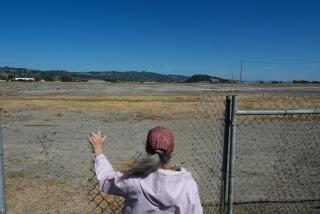Radioactive Tumbleweeds Create Latter-Day Red Menace in Washington
- Share via
RICHLAND, Wash. — The Cold War may be over, but Hanford nuclear reservation continues to battle Russian invaders: radioactive tumbleweeds.
Russian thistle is a dead menace here on the wind-swept desert of south-central Washington. Each winter, the deep taproot on the plant decays, and the spiny brown skeleton aboveground breaks off and rolls away.
“Our dream is that we have this place tumbleweed-free,” says Ray Johnson, a biological control manager for radiation protection at Fluor Hanford, the contractor managing the U.S. Department of Energy site.
But that’s about as likely as a Soviet reunion.
While fewer than 1% of the tumbleweeds corralled and compacted at Hanford are radioactive, the cost of cleanup can run into millions of dollars.
Hanford is the most contaminated nuclear site in the country, built in 1943 for the top-secret Manhattan Project. For 40 years, Hanford made plutonium for the nation’s nuclear arsenal, including the atomic bomb that was dropped on Nagasaki, Japan. The last reactor was shut down in 1986.
Russian thistle, a nonnative or invader species, is a particular problem at underground burial sites for radioactive waste, where their taproots reach down as far as 20 feet and suck up such nasty elements as strontium and cesium.
A stiff winter wind can push the tumbleweed as far away as four miles, and then “we’ve lost control of our contamination,” Johnson says. But most get hung up within a few hundred yards, usually on sagebrush, on fences or in stairwells at the buildings scattered across the site.
Two years ago, uncontrolled contamination spread by fruit flies made Hanford a national laughingstock, spoofed by humor columnist Dave Barry and in the syndicated comic strip “Sylvia.”
The flies had been attracted to a soil fixative with saccharin in the base that was being sprayed on a contaminated site. They flew to a lunch room and spread the taint to nearby trash bins, which wound up at the Richland municipal landfill.
Johnson can chuckle about it now, recalling attempts to find the source of the contamination. As crews ran radiation detectors around the lunch room and passed over a fruit fly, “the contamination flew away,” he recalls.
The journeys of a few thousand fruit flies cost $2.5 million to clean up.
Riding herd on Hanford’s tumbleweeds, and its flying insects, is part of an annual $4-million integrated soil, vegetation and animal control (ISVAC) program, run by subcontractor DynCorp. for Fluor Hanford.
Radiation control specialists survey the tumbleweeds on the 560-square-mile reservation, using Geiger-Mueller counters that click when radioactivity is present. If contaminated tumbleweeds are found, an ISVAC crew disposes of them.
“The weeds are fairly low danger,” says Todd Ponczoch, a radiation control technician, using a Geiger counter to scan tumbleweeds along a fence line. None registered radioactive on a recent trip.
A large, three-pound radioactive tumbleweed might measure out at 150 millirads, or about 1/100th of the allowable annual dose of radiation per person at Hanford.
Radioactive tumbleweeds are corralled by specially trained and clothed workers, tossed into a regulated garbage truck, compacted and disposed of at an on-site low-level waste dump. A trail of paperwork is required as well.
The sites must be satisfactorily cleaned up and covered with six inches of clean soil or gravel.
Nonradioactive tumbleweeds are territory for the Teamsters.
“It’s an easy job. It gets us outside,” says Joe Aldridge, a Teamster from Richland, as he pitchforks a plant into a garbage truck that can hold about 1,800 pounds of tumbleweeds. “Digging ditches is a lot worse.”
The uncontaminated tumbleweeds are dumped in an open pit. Until five or six years ago, the “clean” tumbleweeds were burned and the ash buried. But the state Department of Health put a halt to that practice for fear that some radioactive tumbleweeds might find their way into the mix and disperse contamination into the air.
Preventive measures are also part of the control program; they include backpack, roadside and aerial spraying with herbicide to kill the thistle. Sometimes a bio-barrier--a costly engineered textile--is laid down to block the formation of thistle roots.
“What you’ve got to do is make sure your contaminated areas are tumbleweed-free,” Johnson says.
Clearly, this isn’t Kansas, where at least two enterprising souls are raising Russian thistles, turning them into tumbleweeds and selling them for home decor. But in the vast, open and uncontaminated portions of the reservation, some areas are simply left to nature.
Even Johnson can acknowledge their rightful place in the world.
“If we didn’t have them, the West wouldn’t be the West,” he says, “and we couldn’t sing ‘Tumblin’ Tumbleweeds.’ ”
More to Read
Sign up for Essential California
The most important California stories and recommendations in your inbox every morning.
You may occasionally receive promotional content from the Los Angeles Times.










